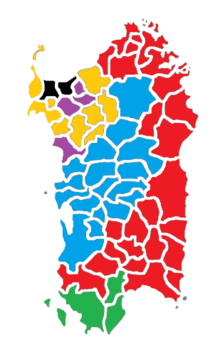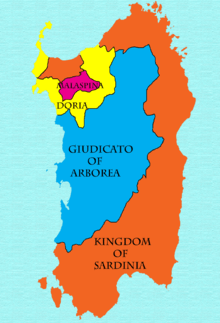Aragonese conquest of Sardinia
| Conquest of Sardinia | |||||||
|---|---|---|---|---|---|---|---|
 Major battles of the campaign | |||||||
| |||||||
| Belligerents | |||||||
|
|
| ||||||
| Commanders and leaders | |||||||
|
|
| ||||||

The Aragonese conquest of Sardinia took place between 1323 and 1326. The island of Sardinia was at the time subject to the influence of the Republic of Pisa, the pisan della Gherardesca family, Genoa and of the genoese families of Doria and the Malaspina; the only native political entity survived was the giudicato of Arborea, allied with the Crown of Aragon. The financial difficulties due to the wars in Sicily (until 1295), the conflict with the Crown of Castile in the land of Murcia and Alicante (1296-1304) and the failed attempt to conquer Almeria (1309) explain the delay of James II of Aragon in bringing the conquest of Sardinia, enfeoffed to him by Pope Boniface VIII in 1297.
The possession of the island of Sardinia was crucial for the Crown of Aragon. Sardinia was abundant of natural resources like silver and salt and had a thriving agro-pastoral economy; also its geographical location ensured more control over the western Mediterranean and the island itself was an indispensable basis for the creation of so-called ruta de las islas (island route) that allowed to halve the time of sailing to reach the rich markets of the Eastern Mediterranean.
Chronology of events
- In 1321 the Cortes of Girona accepted the offer by Sancho of Majorca of twenty galleys,[1] two hundred horses, and a large number of workers useful to undertake the conquest of Sardinia, other support came from the Kingdom of Valencia and the Kingdom of Aragon.
- April 11, 1323 Hugh II of Arborea, become vassal of James II in exchange for maintenance of the dynastic rights over his giudicato, opened hostilities against the Pisans, defeating them between Villanovaforru and Sanluri.[2]
- On May 15, a fleet of three galleys with 200 knights and 2,000 infantry men under the command of Guerau de Rocabertí and his nephew Dalmau de Rocabertí departed from Barcelona in aid of the judge of Arborea, taking position near Quartu, not far from the pisan walled city of Castel di Castro, today Cagliari. It was the vanguard of the great army that meanwhile was gathering in Catalonia.[3]
- After years of preparation a powerful fleet of 300 ships, whose command was placed Admiral Francis Carroz, set out May 31, 1323 from Port Fàngos, near Tortosa, in Tarragona. It was composed of 20 cogs, including the flagship St. Eulalia, 53 galleys, 24 sailing ships and other special vessels (uxer) for the transport of horses and supplies.
- On the advice of Hugh II, the Aragonese fleet landing took place on June 13 in Palmas, Sulcis, where it was created the first bridgehead.[3] Also at the request of the Judge of Arborea the 28 June the Aragonese, under the guidance of the infant Alfonso, began the siege of Villa di Chiesa, today Iglesias, an important mining town founded by Count Ugolino della Gherardesca decades before and now under the control of the Republic of Pisa. The city held seven months before falling to hunger February 7, 1324.[3]
- A week later, on February 13, the Aragonese reached Castel di Castro taking position east of the castle, on the hill of Bonaria.[4] In aid of the besieged, the republic of Pisan sent a fleet of 40 galleys, 12 uxer, 60 boats from Piombino to the command of the Count Manfredi della Gherardesca. Sailed from Porto Pisano, the fleet made a stop at Terranova, today Olbia, where were boarded 200 horsemen from the pisan possessions in Gallura along with other forces.[1] The 25 February, as they approached Castel di Cagliari, the Pisan ships were intercepted by the galleys of Aragon who tried to do battle but the Pisani refused confrontation. After a negotiation the Aragonese conceded to the pisan fleet to landing in freedom near Capoterra.

- On February 29 the Aragonese army and the Pisan were engaged in a pitched battle near the present center of Elmas. The so-called Battle of Lucocisterna ended with a hard-fought victory of the Iberians. On the same day the Pisan fleet was defeated in the waters near Cagliari by the Admiral Francis Carroz. Many Pisans were captured while seeking refuge on ships.[5]
- After the defeat in Lucocisterna the Pisans were forced to accept the surrender and give to the Aragonese their territorial possessions in Sardinia which included the former giudicati of Calari and Gallura.[5] The republic of Pisa maintained, for the moment, the control of Castel of Castro and the surrounding villages of Villanova and Stampace.[5]
- In September 1324 the Doria of Sardinia tried to occupy Sassari, ex-Confederate comune of the Republic of Genoa passed to the Aragonese in 1323,[6] and Pisa, in alliance with Genoa, declare again war to the Crown of Aragon because. In November of that year a fleet of Genoa and Pisa was gathered in the port of Savona. On December 29, the fleet of Aragon led by Francisco Carroz defeated in a naval battle, which took place at the Gulf of Cagliari, the Pisan-Genoese fleet led by Gaspare Doria.[7]
- In the following January the Aragonese led by Ramon de Peralta assaulted Stampace, massacring the population.[7] Pisa had to accept a new capitulation that forced the republic to surrender definitively, Castel di Castro passed to the newborn Kingdom of Sardinia in June 1326, becoming it's capital.[7]
Consequences

In 1347 Aragon and the Doria, which controlled most of the lands of the former Logudoro state in north-western Sardinia, came again into conflict at Aidu de Turdu between Bonorva and Giave.[8]
Threatened by the Aragonese claims of suzerainty and consolidation of the rest of the island, the giudicato of Arborea, under Marianus IV of Arborea, broke the alliance with the Aragonese and together with the Doria declared war to the Iberians. In 1368 an Aborea offensive succeeded in nearly driving out the Aragonese from the island, reducing the "Kingdom of Sardinia" to just the port cities of Cagliari and Alghero and incorporating everything else into their own kingdom. A peace treaty returned the Aragonese their previous possessions in 1388, but tensions continued and in 1391 the Arborean army led by Brancaleone Doria again swept the most of the island into Arborean rule. This situation lasted until 1409 when the army of the giudicato of Arborea suffered a heavy defeat by the Aragonese army in the Battle of Sanluri.
After the sale of the remaining territories for 100,000 gold florins to the giudicato of Arborea in 1420,[9] the "Kingdom of Sardinia" extended throughout the island, except for the city of Castelsardo (at that time called Casteldoria or Castelgenovese), which had been stolen from the Doria in 1448. The subduing of Sardinia having taken a century, Corsica, which had never been wrestled from the Genoese, was dropped from the formal title of the Kingdom.
Notes
- 1 2 Casula 2012.
- ↑ Casula 1994, p. 342.
- 1 2 3 Casula 1994, p. 343.
- ↑ Casula 1994, p. 303.
- 1 2 3 Casula 1994, p. 384.
- ↑ Casula 1994, p. 284.
- 1 2 3 Casula 1994, p. 423.
- ↑ Casula 1994, p. 285.
- ↑ Casula 1994, p. 372.
Bibliography
- Francesco Cesare Casula, La storia di Sardegna, 1994.
- Ramon Muntaner, Crònica, 14th century.
- Antonio Arribas Palau, La conquista de Cerdeña por parte de Jaime II de Aragón, 1952.
Coordinates: 39°34′00″N 8°54′00″E / 39.5667°N 8.9000°E